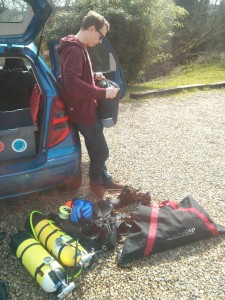Solo Diving?
BSAC says no! BSAC is not just a club, they are the SCUBA diving sports official governing body in the UK and they have decided that diving solo is not safe, and yet there are now several other training agencies that will train you to be self reliant on a dive and another one who will even train you to dive alone. With the limited opportunities I have to dive with the club this year I decided to take one of these courses to become better able to look after myself and not rely on an unknown buddy.
Solo diving is an interesting situation. Would you consider yourself to be diving solo if you are an instructor training an unqualified diver? And what about if you get separated from your buddy? There are a several circumstances when diving when you simply can’t expect your buddy to be of any help to you should you get into trouble. When diving with someone you don’t know, you may find that they also can’t be relied upon in an emergency, at which point it could be too late.
The training I took was the SDI solo diver training course at Wraysbury. You need to be 21+ years old, qualified to Advanced Open Water (SDI qualification, somewhere between Ocean diver and Sports diver) and have logged at least 100 dives to do the course. SDI class the course as a recreational diving course, so you are limited to a maximum of 40m depth and no overhead environments, including mandatory decompression. SDI also stipulate that you must use a dive computer for all your diving. These limits obviously would only apply if you then go diving solo.
The course covers everything you need to know to prepare, plan, and execute a dive completely by yourself. Extra equipment is needed including a backup air supply. This could be a pony cylinder, twinset with isolating manifold, an independent twinset, or a stage cylinder. I dive with sidemounted independent cylinders which it turns out are ideal for solo diving. They are totally independent of each other so a problem with one wouldn’t affect the other. Other important pieces of equipment are backup buoyancy controls (drysuit is fine in open water), spare dSMB with reel, spare mask and cutters for lines and nets.
Other aspects covered in the course are proper (proper) planning of the dive. This covers gas requirements, no-deco limits, entry and exit points, route, navigation, time in and out, potential hazards, site conditions, and other practical considerations that could affect the dive. Having someone on the surface who knows your plan and what to do if you don’t make contact by a certain time is also an essential part of the preparation.
The course also covers when not to dive solo. If you are someone who doesn’t keep an eye on your gas supply and dive computer, or you aren’t very thorough when checking your kit then solo diving probably isn’t for you. There will also be times when you could dive solo but aren’t really in the right frame of mind for it. Part of your pre-dive checks includes asking yourself “am I prepared to get myself out of this if something goes wrong”. And then there are some helpful tips on avoiding a Lance Corporal Jones style “DON’T PANIC” moment.
As you can see this course covers a lot of theory, and I’ve probably missed other bits too. The course doesn’t end there either. There are three dives to do. One is a bit of a checkout dive to make sure you can dive safely enough, with mask clearing, regulator switching, and dSMB deployment skills. The second dive is a helpful gas consumption rate test to give you some numbers that will help you to plan your gas requirements on future dives. And the third is an actual solo dive that you have to plan and carry out by yourself. Your instructor stays out of the water for this one. There are certain things you are expected to do during your solo dive such as give your instructor your plan, enter and exit the water at your specific times, and show that you have adequate gas for the dive. To prove
that you are paying attention to the time during the dive you are asked to deploy your dSMB at a specific time, and you also show you can navigate around the site by visiting specific features.
It was slightly strange being in the water by myself, but it was very nice to be able to dive without trying to keep tabs on someone else, especially in the typically low visibility of Wraysbury. It was also nice to be able to spend as much time as I liked looking at stuff that I wouldn’t want to hold my buddy up for. Things like the crayfish, mussels, and the bryozoans are quite nice to have a bit more of a look at. Also, diving in Wraysbury meant there were a lot less hazards than diving in the sea so it was easy to relax during the dive without worrying about entanglement, DCS, or getting lost. Will I be diving solo again myself? Probably, but only under the right circumstances, and only if a suitable buddy is not available.
I have learned a lot from taking this course. The benefits of diving with a good buddy, the situations where you would be better off by yourself, and areas where I can further improve my own diving. I also have a greater appreciation of the responsibilities we have to each other but also how brilliant it is to dive in a club where the enjoyment and fun of diving is further enhanced by people with a great attitude to diving safely with each other. Thanks everyone, and I hope to be diving with you soon.




